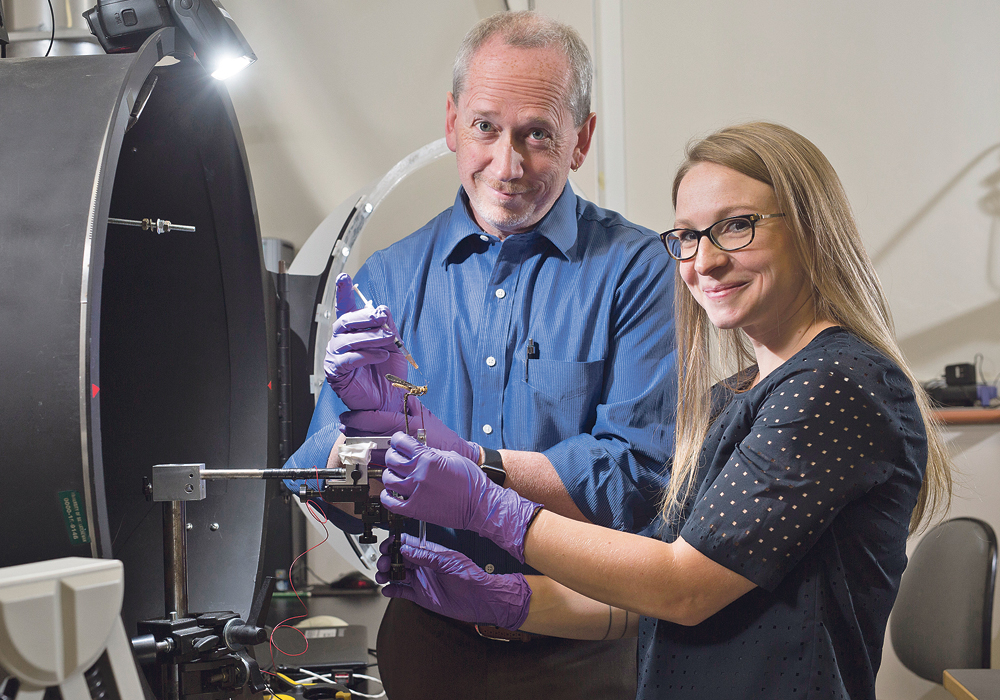Drunk drivers are more likely to get in an accident because the alcohol in their blood impairs vision and delays reaction time.
University of Saskatchewan biologists have identified a comparable phenomenon in locusts, when the insects are exposed to a small dose of insecticide.
“If you’re crossing an intersection and a car is going to come and T-bone you, the normal reaction would be to slam on the brakes or speed up or turn,” said Rachel Parkinson, a PhD student in biology at the U of S.
Read Also

Farming Smarter receives financial boost from Alberta government for potato research
Farming Smarter near Lethbridge got a boost to its research equipment, thanks to the Alberta government’s increase in funding for research associations.
“With these insects (in the study) it’s almost as if they don’t notice that car coming at all.”
For several years Parkinson and Jack Gray, a biology professor and expert in neural control of animal behaviour, have been studying how neonicotinoids, a class of insecticides, alters the vision and motion detection of locusts.
Neonicotinoids, commonly known as neonics, are widely used in crop production and are applied to nearly every canola and corn seed in North America as a seed treatment. The insecticides have been linked to bee deaths and bee colony losses. As well, Health Canada has proposed to phase out three neonics because they may be accumulating in water bodies and putting aquatic insects at risk.
Previous studies have shown that bees, when exposed to low doses of neonics, struggled to find their way back to the hive and had difficulty navigating.
Parkinson wanted to push beyond that level of knowledge and figure out what was causing the navigation problems.
“The question I was asking was why?”
This month, Parkinson and Gray published an answer to that question in the journal NeuroToxicology.
When exposed to “tiny amounts” of a neonic or metabolites, compounds created as the chemical breaks down, the locusts struggled to turn, glide and stop to avoid collisions.
“Our findings suggest that very low doses of the pesticide or its metabolic products can profoundly and negatively affect motion detection systems that flying insects, such as locusts, grasshoppers and bees, need for survival,” Gray said. “Although they are found in the environment … metabolites are not typically tested for toxicity. Our results suggest they should be.”
To reach that conclusion, Gray and Parkinson placed locusts inside a small, laboratory wind tunnel, about one metre by one metre by two metres.
The tunnel was equipped with a small fan, so the air inside moved at the flying speed of a locust.
“When they’re flying inside this wind tunnel, they’re not actually moving forwards or backwards,” Parkinson explained.
“Then we also tether them, loosely, with a bit of fishing line. But they can still steer and turn and do all their normal (flying) behaviour.”
The wind tunnel was equipped with a small screen and Parkinson projected the image of a dot onto the screen. The dot then got bigger, to simulate an object coming toward the locust.
Insects that didn’t receive a dose of neonic or a metabolite were able to turn away from the “collision” with the dot, or they performed a gliding manoevure.
“They will do it almost every single time,” Parkinson said.
“(But) insects treated … they weren’t steering at all.”
The U of S research may explain why insects have trouble navigating or flying when exposed to a neonic.
While the results shouldn’t surprise people because neonics are an insecticide and locusts are insects, the findings may explain how neonics affect locusts, bees and other insects, Parkinson said.
“I would argue the experiments I’ve done are really useful for being able to tease out these really subtle affects, which could have major (impacts) on survival…. Maybe the harm is happening in these more subtle ways.”
Plus, if scientists understand how certain insecticides harm insects, there may be alternative products that don’t cause the same problems with vision and motion detection.
Parkinson has conducted a similar experiment on sulfoxaflor, a Corteva Agri-science insecticide, to see how it affects locusts. She expects to publish the results in about six months.
So far, Parkinson and Gray have focused on locusts because they’re easier to study than bees.
Parkinson plans to study bees this summer, to see if neonics affect their vision and motion detection in the wind tunnel.
“I will be doing a series of experiments … looking at that.”


















